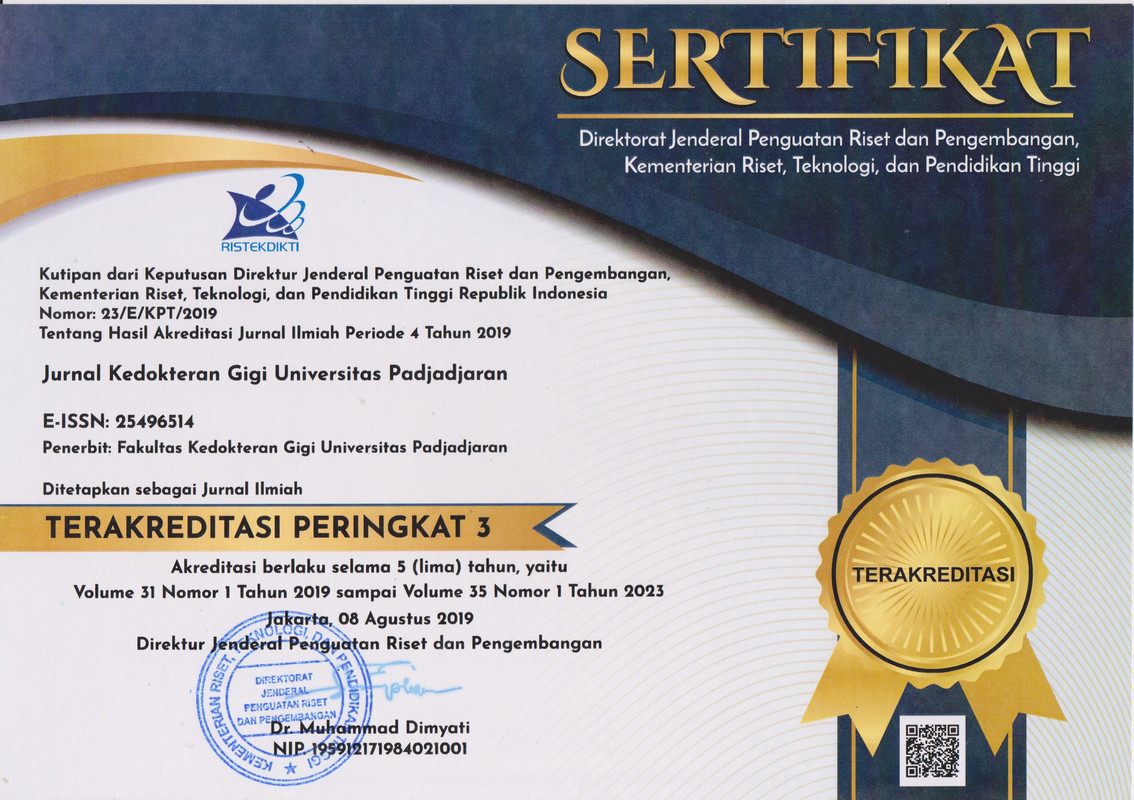Pengaruh penambahan nanoselulosa serat daun nanas terhadap kekasaran permukaan resin akrilik polimerisasi panas: studi eksperimen
Abstract
Effect of addition of nanocellulose pineapple leaf fiber to surface roughness of heat polymerized acrylic denture base: an experimental study
Introduction: Heat polymerized acrylic resin (HPA) is a denture base material that is often used because it has good aesthetic value, but this material has low mechanical properties which is easy to crack or fracture. This can be overcome by the addition of nanocellulose of pineapple leaf fiber which contains 69.5-71.5%. However, surface roughness of HPA must also be considered. The purpose of this study is to analyze the effect of the addition of nanocellulose of pineapple leaf fiber on the surface roughness of the HPA with concentrations of 1% and 1.5%. Methods: The design of this study was a laboratory experiment with 27 samples measuring 65x10x2.5mm. Pineapple leaves fiber were crushed into pulp and delignified to remove lignin and bleaching. Then dry it with an oven and grind with a ball-mill to obtain nanocellulose particles. Each sample was tested with a profilometer to determine the surface roughness value and the effects were analyzed using ANOVA test. Results: Based on the univariate test of the mean value and standard deviation of the surface roughness of HPA without the addition of nanocellulose 0,097±0,032 µm, with the addition of 1% nanocellulose 0,174±0,010 µm and with the addition of 1.5% nanocellulose 0,221±0,034 µm. The one-way Anova test obtained significant results with p=0.001 (p<0.05) and the LSD test with ilia p=0.001 (P<0.05). Conclusion: There was a difference in the surface roughness value of the HPA without and with the addition of 1% and 1.5% pineapple leaf fiber nanocellulose. The 1% concentration is the optimal concentration that can be added to HPA to produce mechanical strength but favorable surface roughness.
Keywords
Full Text:
PDFReferences
Rao DC, Kalavathy N, Mohammad HS, Hariprasad A, Kumar CR. Evaluation of the surface roughness of three heat-cured acrylic denture base resins with different conventional lathe polishing techniques: A comparative study. J Indian Prosthodon Soc. 2015 Oct 1;15(4):374-80. https://doi.org/10.4103/0972-4052.164910
Jubhari EH, Amalia R. Effect of immersion in green tea (Camellia sinensis) solution on the transverse strength of heat cured acrylic resin base. Indonesian Journal of Prosthodontics. 2024;5(2):160-164. https://doi.org/10.46934/ijp.v5i2.273
Singh K, Sharma SK, Negi P, Kumar M, Rajpurohit D, Khobre P: Comparative evaluation of flexural og heat polymerized denture base resin after reinforcement with glass fibres and nylon fibres: an in vitro study, Adv Hum Bio. 2016,6;91-4. https://doi.org/10.4103/2321-8568.190315
Porwal A, Khandelwal M, Punia V, Sharma V. Effect of denture cleansers on color stability, surface roughness, and hardness of different denture base resins. J Indian Prosthodon Soc. 2017 Jan 1;17(1):61-7. https://doi.org/10.4103/0972-4052.197940
Hammed HK, Rahman HA. The effect of addition nano particle ZrO2 on some properties of autoclave processed heat cure acrylic denture base material. J Bagh College Dent 2015;27(1):32-9. https://doi.org/10.12816/0015262
Fatriasari W, Masruchin N, Hermiati E. Selulosa, Karakteristik Dan Pemanfaatannya. Buku., LIPI Press; Jakarta: 2019. h. 63.
Gunawan M, Lestari N. Preparation of hydrogel based on pineapple leaf cellulose microcrystalline (ananas comosus l. merr) with variation in glutaraldehyde volume. J Indah Sains dan Klinis. 2020 Dec 31;1(1):12-7. https://doi.org/10.52622/jisk.v1i1.3
Rusli R, Fatimah S, Gusti HI, Jumrah E. Potensi karbon aktif kulit nanas (ananas comosus) sebagai adsorben logam berat pb dengan perbandingan aktivator naoh dan hcl. J kimia saintek dan pendidikan. 2025 Jul 16;9(1):10-8. https://doi.org/10.51544/kimia.v9i1.6078
Asim M, Abdan K, Jawaid M, Nasir M, Dashtizadeh Z, Ishak MR, Hoque ME. A review on pineapple leaves fibre and its composites. Inter J Polymer Scie. 2015;2015(1):1-16.950567. https://doi.org/10.1155/2015/950567
Wirayuni KA, Saputra IMHD. Immersion of heat polymerized acrylic resin dental base in arak bali against surface roughness : perendaman basis gigi tiruan resin akrilik polimerisasi panas dalam minuman arak bali terhadap kekasaran permukaan. Interdental J Ked Gi (IJKG). 2021;17(1):22–26. https://doi.org/10.46862/interdental.v17i1.2051
Rukmana L, Adrian N. Pengaruh metode pembersihan kombinasi terhadap kekasaran Basis gigi tiruan akrilik. Jurnal Kedokteran Gigi Terpadu. 2022 Aug 2;4(1). https://doi.org/10.25105/jkgt.v4i1.14278
Sharma P, Garg S, Kalra NM. Effect of denture cleansers on surface roughness and flexural strength of heat cure denture base resin-an in vitro study. J Clinical diagnos Res: JCDR. 2017;11(8):ZC94. https://doi.org/10.7860/JCDR/2017/27307.10483
Angelia V, Wahyuni S, Ritonga S, Amesta VR. Pengaruh penambahan kitosan pada bahan basis gigi tiruan resin akrilik polimerisasi panas terhadap kekasaran permukaan dan jumlah Candida albicans: studi eksperimental laboratoris. J Ked Gi Univ Padj. 2023;35(3):230-7. https://doi.org/10.24198/jkg.v35i3.47990
Silva WJ, Gonçalves LM, Viu FC, Leal CM B, Barbosa CMR, Del Bel Cury AA. Surface roughness influences Candida albicans biofilm formation on denture materials. Rev Odonto Cienc. 2016;31(2):54-58. https://doi.org/10.15448/1980-6523.2016.2.15324
Fadriyanti O, Alamsyah Y, Rabianti D. Evaluasi pemakaian denture adhesive pada gigi tiruan lengkap resin akrilik: Scoping Review. Menara Ilmu. 2022;16(2):55-62. https://doi.org/10.31869/mi.v16i2.3289
Arib MF, Rahayu MS, Sidorj RA, Afgani MW. Experimental research dalam penelitian pendidikan. Innovative: J Soc Scie Res. 2024 Jan 22;4(1):5497-511. https://doi.org/10.31004/innovative.v4i1.8468
Selma JR, Setiadi WL, Rinawati S. Penambahan nanoselulosa sekam padi terhadap kekasaran permukaan basis gigi tiruan resin akrilik polimerisasi panas. Maj Ked Gi Insisiva, 2021;10(2):45-50. https://doi.org/10.18196/di.v10i2.12309
Riyadi W, Purasasmita BS, Imam DN. Penambahan nanoselulosa sekam padi terhadap kekuatan fleksural basis gigi tiruan resin akrilik polimerisasi panas. E-Prodenta J Dent. 2020;4(2):336-42. https://doi.org/10.33476/ms.v2i1.1636
Lismeri L, Irmalinda G, Darni Y, Herdiana N. Aplikasi fiber selulosa dari limbah batang ubi kayu sebagai film komposit berbasis Low Density Polyethylene (LDPE). Yogyakarta: Prosiding Seminar Nasional Kulit, Karet, dan Plastik ke-7. 2018. p. 69- 82.
Ashraf MA, Peng W, Zare Y, Rhee KY. Effects of size and aggregation/agglomeration of nanoparticles on the interfacial/interphase properties and tensile strength of polymer nanocomposites. Nanoscale research letters. 2018;13:1-7. https://doi.org/10.1186/s11671-018-2624-0
Deng F, Li MC, Ge X, Zhang Y, Cho UR. Cellulose nanocrystals/poly (methyl methacylate) nanocompositesfilms: effect of preparation method and loading on the optical, thermal, mechanical, and gas barrier properties. Polymer Composites 2015;2(1):1-10. https://doi.org/10.1002/pc.23875
Irnawati D, Widjijono, Sunarintyas S. Effect of zinc oxide nanoparticles on optical characteristics and surface roughness of polymethyl methacrylate. J Int Dent Med Res. 2025;18(1):34–40.
DOI: https://doi.org/10.24198/jkg.v37i2.60102
Refbacks
- There are currently no refbacks.
Copyright (c) 2025 Jurnal Kedokteran Gigi Universitas Padjadjaran
INDEXING & PARTNERSHIP

Jurnal Kedokteran Gigi Universitas Padjadjaran dilisensikan di bawah Creative Commons Attribution 4.0 International License






.png)

















